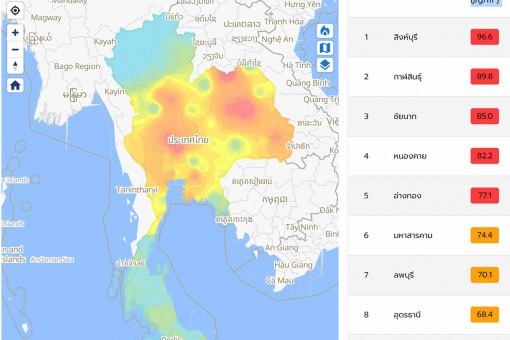PUBLISHED : 11 Dec 2023 at 10:06

People in 50 provinces awoke to harmful levels of ultrafine dust in the air they breath on Monday morning, according to the Geo-Informatics and Space Technology Development Agency (Gistda).
Worst affected areas were in the Central plains and the Northeast.
Gistda reported at 7am on Monday on its website pm25.gistda.or.th that 50 of the 77 provinces, mostly central plains and northeastern provinces, were shrouded in a harmful density of particulate matter 2.5 micrometres and less in diameter (PM2.5).
The levels ranged from 37.7 to 96.6 microgrammes of PM2.5 per cubic metre of air over the past 24 hours. The goverrnment’s new safety threshold is 37.5µg/m³.
At 7am, the worst level, 96.6µg/m³, was recorded in Sing Buri, followed by 89.8µg/m³ in Kalasin, 85.0µg/m³ in Chai Nat, 82.2µg/m³ in Nong Khai and 77.1µg/m³ in Ang Thong. These provinces were in the red levels of PM2.5, meaning the air pollution could seriously affect a person’s health.
The levels were 47.7µg/m³ in Bangkok, 44.6µg/m³ in Samut Prakan, 44.4µg/m³ in Nonthaburi, 50.1µg/m³ in Nakhon Pathom and 45.2µg/m³ in Pathum Thani.
People in 50 provinces (65%) out of 77 provinces nationwide were suffering under the smog. Only 27 provinces were spared unsafe levels, most in the North or the South.
They were the northernmost province of Chiang Rai, with the lowest reading oif 7.7µg/m³, Mae Hong Son, Chiang Mai, Lamphun, Pattani, Surat Thani, Krabi, Chumphon, Nakhon Si Thammarat, Phayao, Lampang, Phuket, Phangna, Satun, Ranong, Songkhla, Yala, Phrae, Nan, Phatthalung, Trang, Narathiwat, Trat, Bung Kan, Chanthaburi, Nakhon Nayok and Tak.
Air pollution levels had worsened compared with Sunday afternoon.

